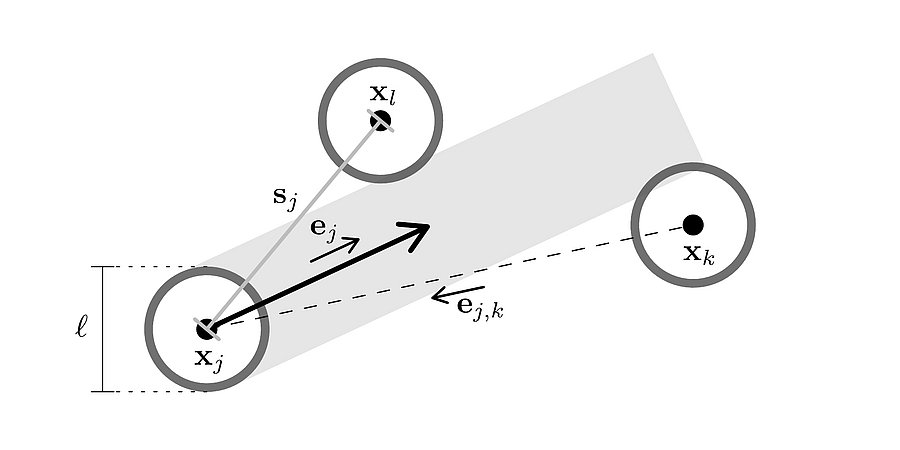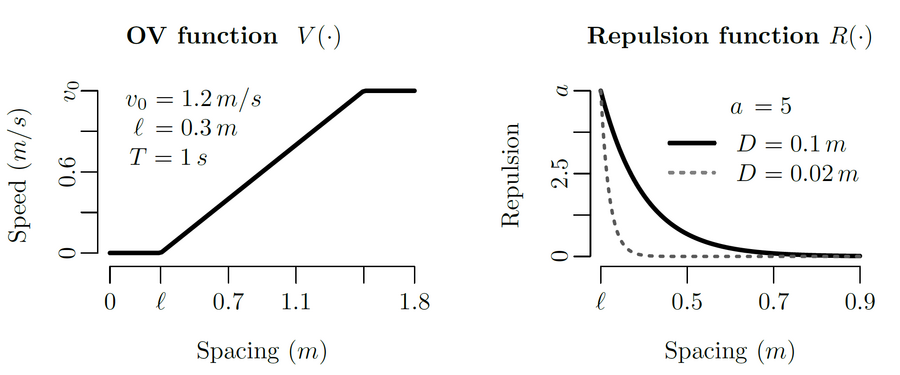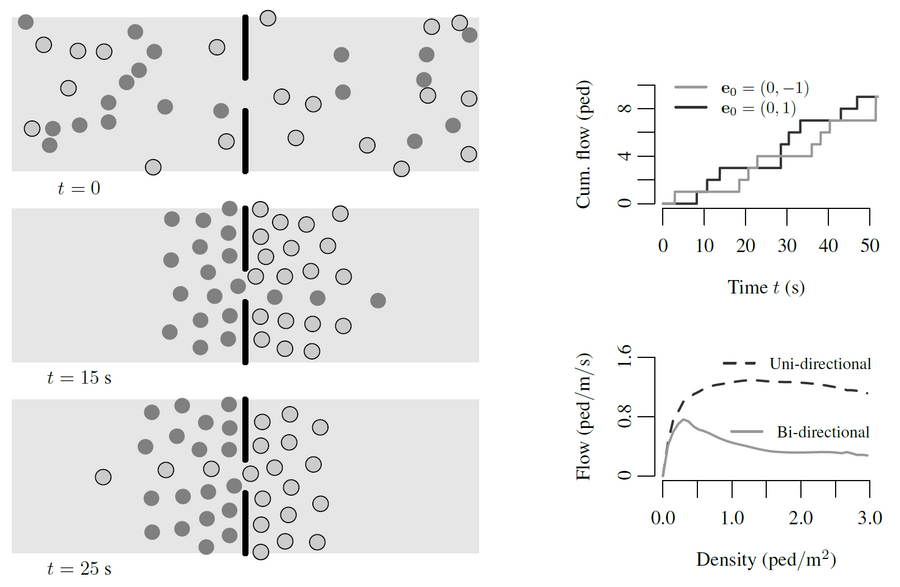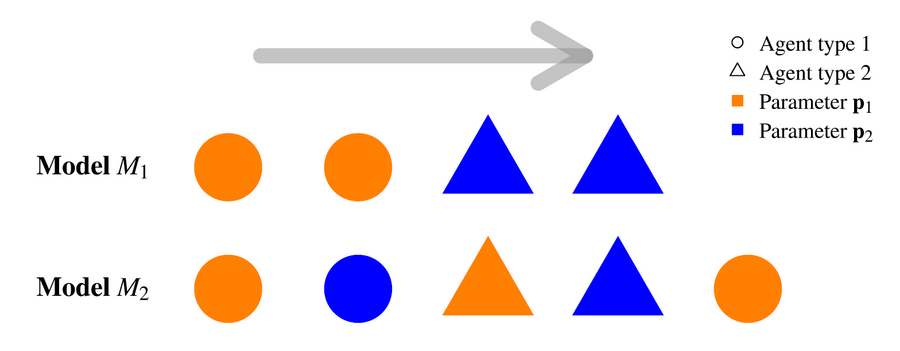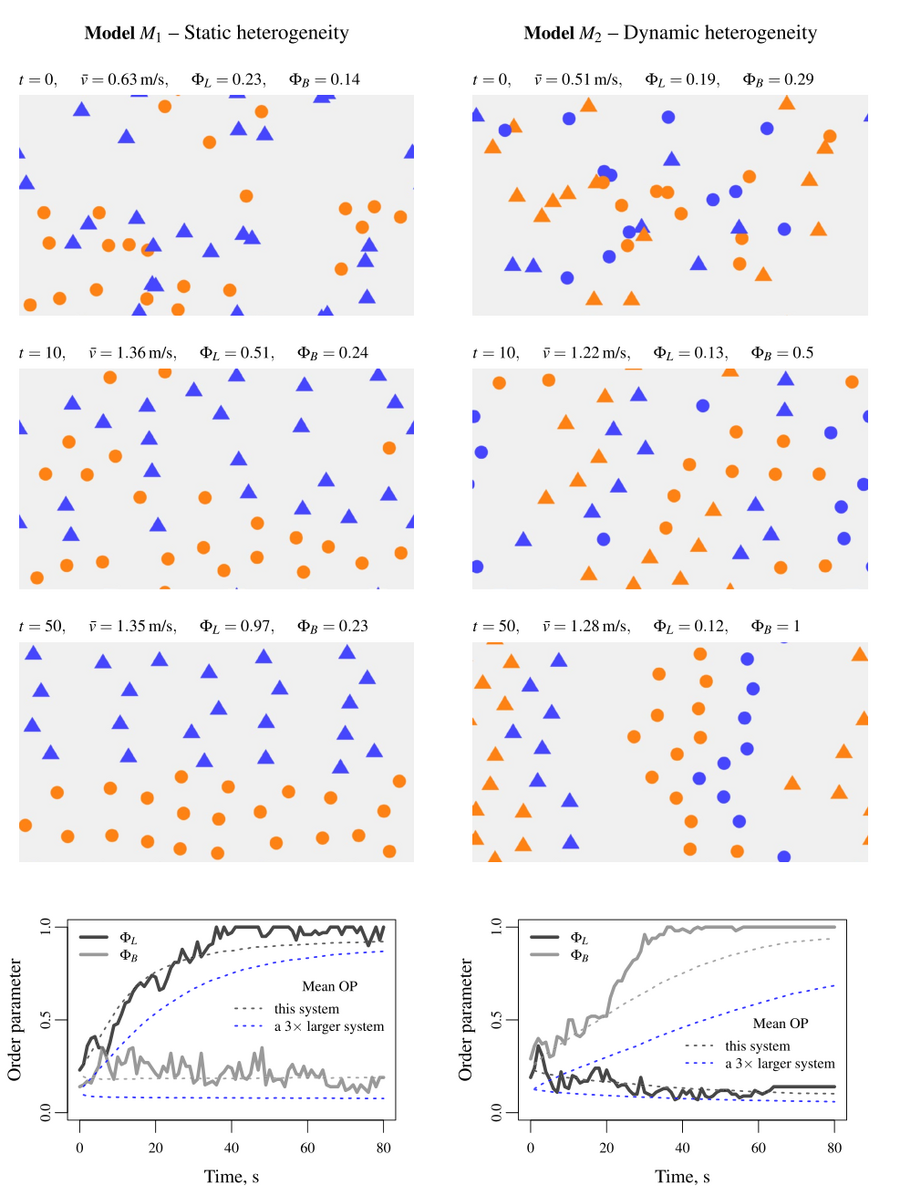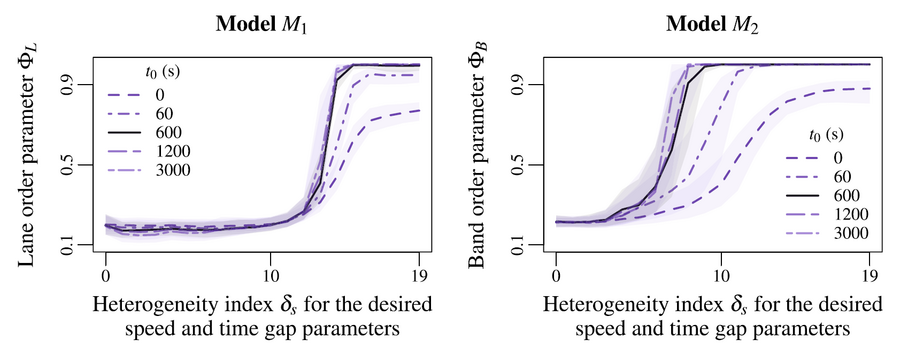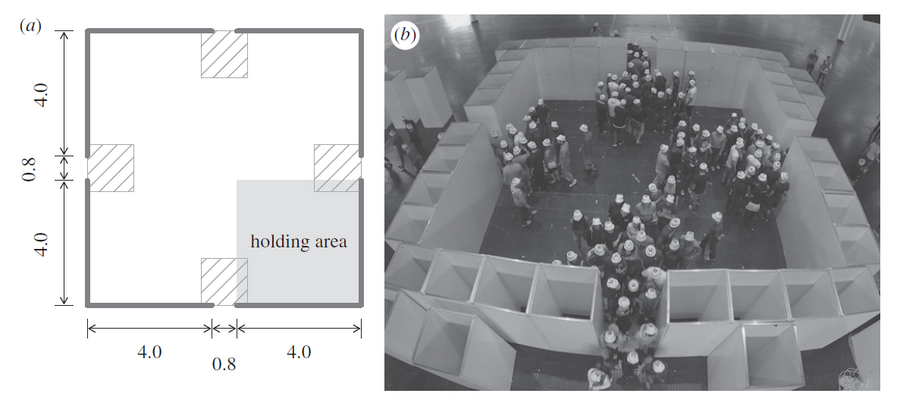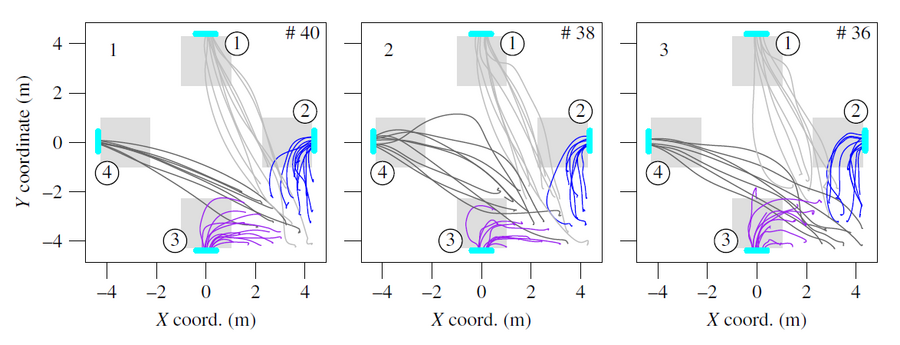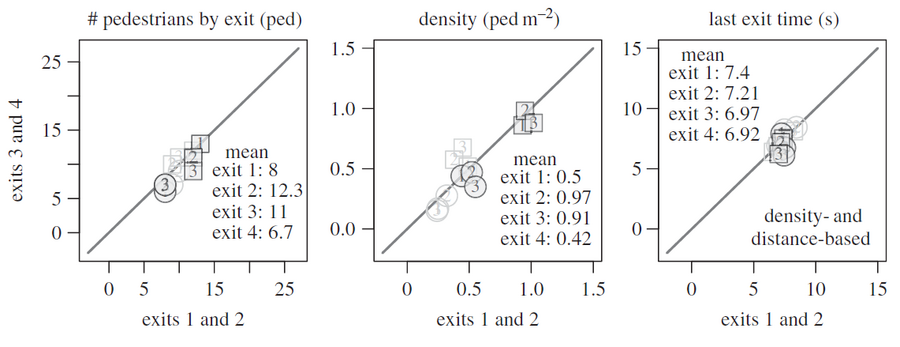Collision-free pedestrian model
Microscopic pedestrian models are frequently used in traffic engineering and safety engineering to simulate crowd behaviors in different scenarios. The social force model is a second-order model based on a superposition of exponential repulsions with the neighbors (the social forces). Despite its simplicity, SFM can describe realistic dynamics and self-organized phenomena (lane formation, alternance at bottlenecks, etc.) for fine tunings of the parameter. However, inertia mechanisms can also provide undesired overlapping effects of the pedestrians (“tunneling” or penetration of particles), oscillating behaviors, as well as additional numerical complexity related to simulation of second order models.
In contrast to acceleration-based models, the velocity in velocity-based models is instantaneously adjusted to the neighborhood and the environment with no inertia or reaction time. Such a modelling approach is largely inspired by motion planning in robotics. Constraints on the velocity in case of contact allow to model hard-core body exclusion (volume exclusion) and tdescribe collision-free pedestrian dynamics with no overlapping. In the collision-free model, the speed depends, as for optimal velocity traffic models, on the distance spacing in front, while the direction, as the social force and gradient navigation models, results from exponential repulsion with the neighbors and the obstacles. The model is collision-free by construction, and can describe different self-organization such as jamming and clogging at bottlenecks, lane formation, freezing by heating effect, or intermittent counter flow at bottlenecks (see the videos #1, #2, #3, #4; a presentation of the collision-free pedestrian model is available here). Yet, the numerical complexity of the systems is significantly lower than those of acceleration-based models.
Modelling mixed urban traffic
In a city, the street network is heterogeneous in terms of composition but also of infrastructure due to the adaptation of the layout to more and more different users. Current urban traffic flow in European city centers are composed of road vehicles, pedestrians, bicycles, scooters, and other motorized or not personal mobility devices (PMD). The conception of intelligent transportation systems is generally based on simulation analyses. Numerous models exist for the different types of users, e.g. car-following models for traffic flow or force-based models for pedestrian crowds. However, only few studies address the interactions between agents of different types (e.g., pedestrians and cyclists). These questions rely on modeling the flow heterogeneity and associated interaction mechanisms.
Static heterogeneity in the agent characteristics
We consider in the first heterogeneity model two agent types and attribute statically two parameter settings to the two agent types. We aim here to model different agent types (for instance, pedestrians and bicycles) with specific characteristics in terms of desired speed, agent size, etc. This kind of heterogeneity is usually called quenched disorder in solid-state physics. It refers to static heterogeneity features remaining constant (i.e., quenched) over time. Such a mechanism results in the formation of lanes.
Dynamic heterogeneity in the interactions
In the first heterogeneity model, we attribute dynamically the two parameter settings according to the type of the closest agent in front. The parameter setting is the first one if the agent in front is of the same type, while it is the second in case of interaction with another agent type. Such a mechanism may be realized in mixed urban traffic where cyclists or electric scooter drivers adapt their behaviour, e.g., increasing the time gap or reducing their desired speed, when following a group of pedestrians. The heterogeneity features are time-dependent. They are usually called annealed disorder in the literature. Interestingly, such a mechanism results in the formation of bands.
Tactical exit choice model
Pedestrians exhibit many intelligent behaviors. For instance, experiments show that load balancing occurs in complex geometries over different possible exits, optimising the global leaving time. In the literature, basic tactical models for the exit choice solely depend on the distance to the exits. They do not reproduce load balancing when the pedestrians are initially inhomogeneously distributed. More sophisticated models based on simulation prediction of the travel time over the possible exits allow describing the balancing. Yet, they are numerically very costly.
The travel time is related to the speed of the pedestrian. Yet the pedestrian speed is relatively well described by the pedestrian fundamental diagram, a phenomenological relation linking the speed (or the flow) to the density. In the distance- and density-based tactical model, the choice of the exit is determined by a linear combination of the distance to the exit and the density in front of the exit. A linear discriminant analysis allows to calibrate the coefficients. Simulation results show that the minimal model is able to reproduce the load balancing without requiring complex calculations for the travel time.
- C. Gnendiger, M. Chraibi and A. Tordeux, "Come together: A unified description of the escalator capacity", PLOS ONE, vol. 18, no. 3, pp. e0282599, 2023.
- A. Tordeux and C. Totzeck, "Multi-scale description of pedestrian collective dynamics with port-Hamiltonian systems", Networks and Heterogeneous Media, vol. 18, no. 2, pp. 906-929, 2023.
- R. Korbmacher, A. Nicolas, A. Tordeux and C. Totzeck, "Time-Continuous Microscopic Pedestrian Models: An Overview", Bellomo, Nicola and Gibelli, Livio, Eds. Cham: Springer International Publishing, 2023, pp. 55-80.
- B. Khelfa, R. Korbmacher, A. Schadschneider and A. Tordeux, "Heterogeneity-induced lane and band formation in self-driven particle systems", Scientific Reports, vol. 12, no. 1, pp. 1-11, 2022. Nature Publishing Group.
- B. Khelfa, R. Korbmacher, A. Schadschneider and A. Tordeux, "Initiating lane and band formation in heterogeneous pedestrian dynamics", Collective Dynamics, vol. 6, pp. 1-13, 2022.
- R. Subaih, M. Maree, A. Tordeux and M. Chraibi, "Questioning the anisotropy of pedestrian dynamics: An empirical analysis with artificial neural networks", Applied Sciences, vol. 12, no. 15, pp. 7563, 2022. MDPI.
- J. Cordes, M. Chraibi, A. Tordeux and A. Schadschneider, "Time-to-collision models for single-file pedestrian motion", Collective Dynamics, vol. 6, pp. 1-10, 2022.
- J. Wang, M. Boltes, A. Seyfried, A. Tordeux, J. Zhang and W. Weng, "Experimental study on age and gender differences in microscopic movement characteristics of students", Chinese Physics B, vol. 30, no. 9, pp. 098902, 2021. IOP Publishing.
- M. Friesen, H. Gottschalk, B. Rüdiger and A. Tordeux, "Spontaneous wave formation in stochastic self-driven particle systems", SIAM Journal on Applied Mathematics, vol. 81, no. 3, pp. 853-870, 2021. SIAM.
- J. Cordes, A. Schadschneider and A. Tordeux, "The trouble with 2nd order models or how to generate stop-and-go traffic in a 1st order model" in Traffic and Granular Flow 2019, Springer, 2020, pp. 45--51.
- A. Tordeux, A. Schadschneider and S. Lassarre, "Stop-and-go waves induced by correlated noise in pedestrian models without inertia", Journal of traffic and transportation engineering (English edition), vol. 7, no. 1, pp. 52--60, 2020. Elsevier.
- A. Schadschneider and A. Tordeux, "Noise-induced stop-and-go dynamics in pedestrian single-file motion", Collective Dynamics, vol. 5, pp. 356-363, 2020.
- Q. Xu, M. Chraibi, A. Tordeux and J. Zhang, "Generalized collision-free velocity model for pedestrian dynamics", Physica A: Statistical Mechanics and its Applications, vol. 535, pp. 122521, 2019. Elsevier.
- V. Kurtc, M. Chraibi and A. Tordeux, "Automated quality assessment of space-continuous models for pedestrian dynamics" in International Conference on Traffic and Granular Flow, 2019, pp. 317-325.
- J. Wang, M. Boltes, A. Seyfried, A. Tordeux, J. Zhang, V. Ziemer and W. Weng, "Influence of gender on the fundamental diagram and gait characteristics" in International Conference on Traffic and Granular Flow, 2019, pp. 225-234.
- A. Tordeux, A. Schadschneider and S. Lassarre, "Noise-induced stop-and-go dynamics" in International Conference on Traffic and Granular Flow, 2019, pp. 337-345.
- M. Boltes, J. Zhang, A. Tordeux, A. Schadschneider and A. Seyfried, "Empirical results of pedestrian and evacuation dynamics", Encyclopedia of Complexity and Systems Science, vol. 16, pp. 1-29, 2018. Springer Berlin, Germany.
- Y. Xiao, M. Chraibi, Y. Qu, A. Tordeux and Z. Gao, "Investigation of Voronoi diagram based direction choices using uni-and bi-directional trajectory data", Physical Review E, vol. 97, no. 5, pp. 052127, 2018. APS.
- M. Chraibi, A. Tordeux, A. Schadschneider and A. Seyfried, "Modelling of pedestrian and evacuation dynamics", Encyclopedia of Complexity and Systems Science, pp. 1-22, 2018. Springer Heidelberg.
- J. Wang, W. Weng, M. Boltes, J. Zhang, A. Tordeux and V. Ziemer, "Step styles of pedestrians at different densities", Journal of Statistical Mechanics: Theory and Experiment, vol. 2018, no. 2, pp. 023406, 2018. IOP Publishing.
- A. Schadschneider, M. Chraibi, A. Seyfried, A. Tordeux and J. Zhang, "Pedestrian dynamics: From empirical results to modeling" in Crowd Dynamics, Volume 1, Springer, 2018, pp. 63-102.
- A. Tordeux, M. Chraibi, A. Schadschneider and A. Seyfried, "Influence of the number of predecessors in interaction within acceleration-based flow models", Journal of Physics A: Mathematical and Theoretical, vol. 50, no. 34, pp. 345102, 2017. IOP Publishing.
- A. K. Wagoum, A. Tordeux and W. Liao, "Understanding human queuing behaviour at exits: an empirical study", Royal Society Open Science, vol. 4, no. 1, pp. 160896, 2017. The Royal Society Publishing.

